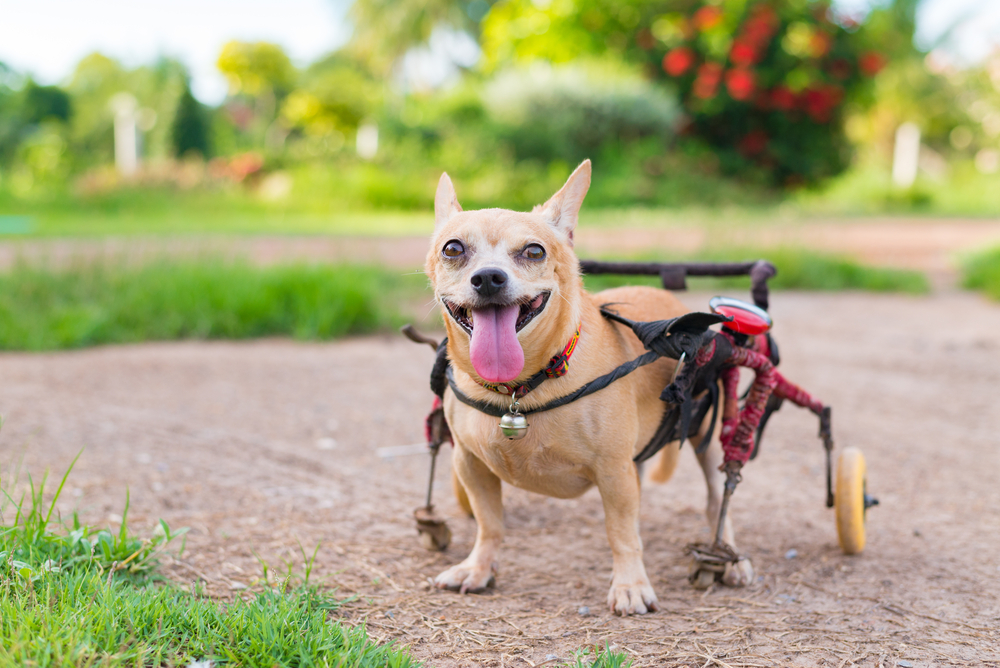Having another living creature rely solely on you for all her needs is a big responsibility, and a disabled pet can be a big challenge. Paired with managing cancer treatment, a missing limb, blindness, or deafness can prove a difficult burden for you and your pet to handle. But, a pet with a disability has as much love to share as one who has four legs, and can still return your adoring gaze. To help return your three-legged, deaf, or blind pal’s devotion, we’ve outlined a few ways to make caring for your special pet easier.
How to care for a pet with an amputated limb
Many pet owners cannot fathom their pet with only three legs, but almost all pets do as well with three legs as they do with four. There’s an adjustment phase after the amputation surgery, but pets don’t realize they’re missing a leg, and usually cope well. We often recommend limb amputation for cancers that attack the limbs or long bones, like osteosarcoma or nerve sheath tumors, as the amputation will completely remove the malignant growth, and the pain.
Fortunately, although you and your pet will likely need a little help adjusting to life without a leg, most pets learn to manage well. The following recommendations will help your pet transition to life as an amputee:
- Use a rehabilitation therapist — Help your pet build strength by working with a pet rehabilitation specialist. Different muscle groups will be used, as your pet learns to compensate for her missing limb, and rehab sessions can help her find a new center of balance, and to develop muscles.
- Prevent weight gain — Keep your pet at a healthy weight. Ideally, your furry pal should be lean and trim, to avoid any extra pressure on the remaining limbs.
- Implement a joint-health regimen — A wide variety of joint supplements are available for pets, to help maintain joint cartilage, and reduce inflammatory responses in overworked joints. We can recommend the product that would work best for your three-legged friend, based on her health condition.
Although sacrificing a limb seems drastic, amputation can save your pet’s life. Many pets get around well once they adjust to their missing limb, and go on to live a normal, comfortable life.
How to care for a deaf pet
Pets often lose their hearing with age, but some pets, especially pure white dogs, are born deaf. Regardless of how deafness occurred, most deaf pets live a perfectly normal life, as long as their safety is properly considered. Since your pet will be unable to hear you call her name if danger is near, take the following steps to protect her:
- Secure her environment — Always keep your pet in a secure environment, whether a fenced-in yard, or inside your home. Check your fence’s perimeter regularly for holes or breaks that would allow your pet to escape, or other animals to enter.
- Keep her leashed — When walking your deaf dog, keep her on a leash or long lead, to grant her freedom to explore and sniff to her heart’s content, but still keep her safe and secure. Hand signals won’t work if your dog wanders out of eyesight, so keep your pet nearby with a leash.
Also, keep your deaf pet’s comfort and security in mind while you are at home. Avoid sneaking up on her while she’s sleeping, eating, or chewing on a high-value item. Deaf pets can be easily startled, if they don’t see you approaching, and may bite or scratch. Ensure your pet sees you before you approach her, to avoid scaring her, and causing a defensive reaction. Except for these few differences, your deaf pet will live a happy, normal life, and learn to follow your hand signals.
How to care for a blind pet

A blind pet can be more challenging to care for than a deaf pet, as they tend to bump into furniture, or otherwise hurt themselves while attempting to navigate obstacles. If you have another pet in your home, your blind pet will likely pair up with her “seeing-eye” cat or dog for assistance. Consistency is key for blind pets, since they will learn the layout and patterns of your home and yard, which allows them to move more confidently. Avoid rearranging your furniture, and keep items picked up off the floor that could cause your pet to trip. Block access to stairs and potential danger zones, and use verbal cues to guide your pet. Proper management will help her live comfortably, despite her loss of sight.
How to care for yourself if your pet has a disability
If your beloved companion suffers from a cancer-related disability, you’re faced with two unpleasant conditions, which can be mentally and emotionally overwhelming. When caring for your disabled pet, ensure you also take care of yourself, and get help, so you can cope mentally, emotionally, and physically, and avoid becoming rundown and weary. Here are two ways to keep your spirits and strength up, when caring for your disabled pet:
- Join a support group — People who live with disabled pets are an excellent resource. They can provide a plethora of tips and tricks on how to best care for your furry pal, and offer firsthand experience on daily life, in addition to showering you with empathy and encouragement. These groups may also have used equipment for sale that is designed to make caring for your disabled pet easier, as some pets will have lost their battle, and no longer need their wheelchairs, slings, ramps, or harnesses.
- Evaluate your mental and emotional health — Taking care of a disabled pet with a terminal illness is incredibly difficult. The never-ending drain on your mental and emotional well-being can be exhausting, especially combined with the thought that your beloved companion is fading away from cancer. Although you love your pet dearly, and want to perform all the tasks necessary to keep her comfortable, reach out for aid. Simply leaving your pet in good hands, and not worrying about her care for a few hours’ break, can do wonders for your well-being.
When caring for your disabled pet, you can always turn to the Pearland Animal Cancer and Referral Center team for assistance. Give us a call, so we can help support you, and your beloved companion.


